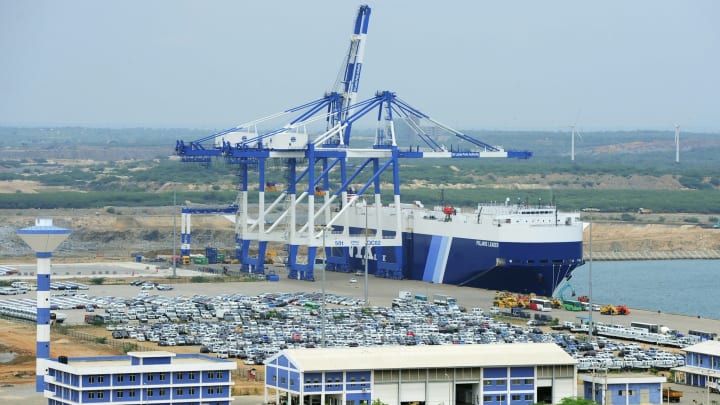Can We Eat Money?
Inflation high, supplies low, despair on the island nation.

Sri Lanka, historically known as Ceylon, is a South Asian island country whose official name is the Democratic Socialist Republic of Sri Lanka. It is located in the Indian Ocean to the southwest of the Bay of Bengal and to the southeast of the Arabian Sea with a population of not more than 22 million. Sri Lanka has a 3,000-year known history, with evidence of prehistoric human habitation. It has a diverse cultural history.
“Whoever controls the Indian Ocean will dominate Asia”.
- Alfred Mahan
From the early days of the historical Silk Road trade route to today’s so-called maritime Silk Road, Sri Lanka’s geographic position and deep harbors have made it of significant strategic importance. Because of its strategic location, it was already well-known to both Far Easterners and Europeans.
After observing its political crisis and economic crisis, one would be surprised given its strategic location in the Indian Ocean and historical civilizational support for its culture. Currently, Srilanka is going through its bad phase witnessing civil protest and political unrest.
After a month of intense civilian-led protests over Sri Lanka’s deteriorating economy, Gotabaya Rajapaksa fired his older brother from the post of PM and appointed a new one. This would remove the grip of the Rajpaksha Family dynasty over Srilanka’s politics.
But how does this country reach here?

Many people blame Sri Lanka’s economic problems on previous governments’ mismanagement of the country’s finances, which included increasing foreign debt and ongoing infrastructure spending. The country’s economic future is in jeopardy after it defaulted on payments on a mountain of foreign debts, believed to be worth $50 billion, for the first time since gaining independence from the British in 1948.
Food prices surged and power outages were more frequent during the latter two years of the Covid-19 outbreak, signaling an oncoming economic disaster in Sri Lanka. Sri Lanka’s overall debt due this year is estimated to be around $7 billion. The Rajapaksa administration also implemented tax cuts in 2019, slashing the value-added tax (VAT) rate — the tax applied to imports and domestic supplies — from 15 percent to 8 percent, which contributed to a decrease in the country’s revenue.

Sri Lanka’s economic troubles are exacerbated by the country’s growing foreign debt, which was used to pay for former President Mahinda Rajapaksa’s ambitious infrastructure development during his two terms as Prime Minister. Sri Lanka borrowed heavily from state-owned Chinese banks to fund infrastructure projects, notably a contentious port project in the Hambantota area. Sri Lanka accumulated a $5 billion debt to China alone during the previous decade, accounting for a significant share of its entire foreign debt.
In 2019, tourism suffered after a series of church bombings that killed nearly 300 people, including some foreign nationals. The next year, the Covid-19 pandemic halted tourism and other major sectors, spurring a global economic downturn, which depleted the country’s foreign reserves. Russia’s invasion of Ukraine also have a negative impact on Srilanka’s tourism as both nations were the leading source of tourism.

In the midst of the current conflict, the Sri Lankan government ordered a 13-hour daily power interruption. As the economic crisis worsened, many people were unable to execute their jobs, resulting in widespread dissatisfaction. Thousands of Sri Lankans came to the streets to protest the country’s worsening problems in the weeks after the power outages. As demonstrators clashed with police, President Rajapaksa announced a state of emergency. Soon after the emergency rule was adopted, the entire Sri Lankan government Cabinet resigned in protest, prompting Rajapaksa to repeal it which resulted in a political crisis.
The new Government was discussing a bailout package with the International Monetary Fund, which had determined that the country’s debt was unsustainable. With the whole world engaging in Russia’s invasion of Ukraine and finding a way to tighten economic sanctions, Srilanka has emerged as a case study for geopolitical analysts. It also revealed the woes around China’s Belt and Road initiative and debt trap which was more on paper.
Now, other countries submitted to BRI may rethink their policy decisions.
About the Creator
InfiniteFlame
Writer and enthusiastic about New World. I like to share the values of Democracy, Eqality, Humanity.
Reader insights
Outstanding
Excellent work. Looking forward to reading more!
Top insights
Compelling and original writing
Creative use of language & vocab
Easy to read and follow
Well-structured & engaging content
Excellent storytelling
Original narrative & well developed characters
Expert insights and opinions
Arguments were carefully researched and presented
Eye opening
Niche topic & fresh perspectives
Masterful proofreading
Zero grammar & spelling mistakes
On-point and relevant
Writing reflected the title & theme






Comments (1)
Uf terrible for the people there :/